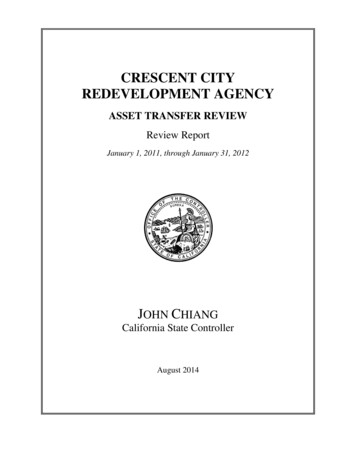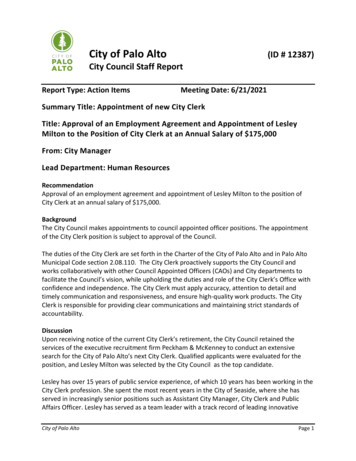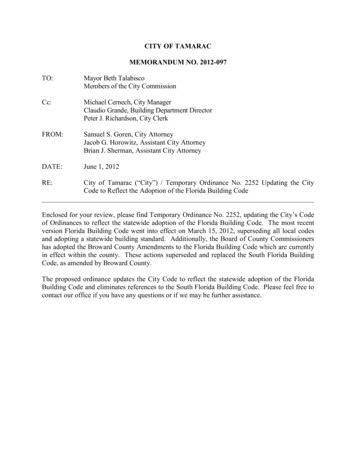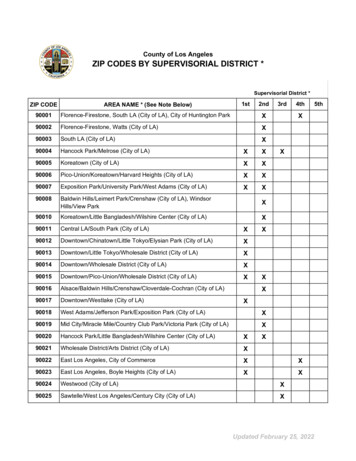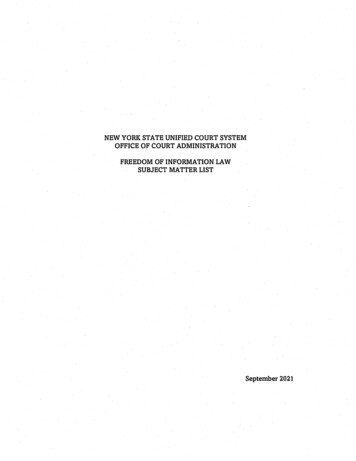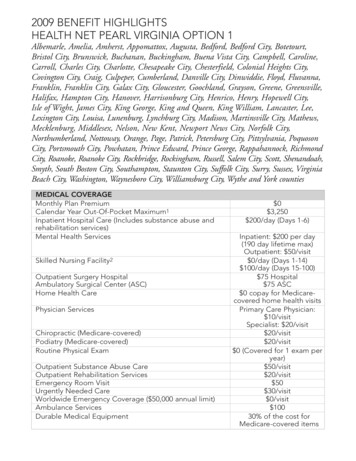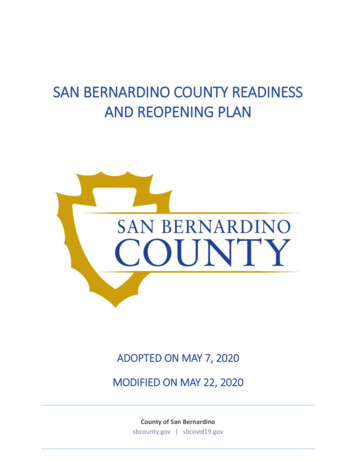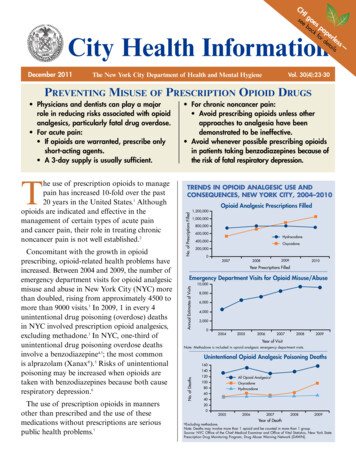
Transcription
CHIse goeeba s pck apfo err d leeta ssil —City Health InformationDecember 2011Vol. 30(4):23-30The New York City Department of Health and Mental HygienePREVENTING MISUSE OF PRESCRIPTION OPIOID DRUGSConcomitant with the growth in opioidprescribing, opioid-related health problems haveincreased. Between 2004 and 2009, the number ofemergency department visits for opioid analgesicmisuse and abuse in New York City (NYC) morethan doubled, rising from approximately 4500 tomore than 9000 visits.3 In 2009, 1 in every 4unintentional drug poisoning (overdose) deathsin NYC involved prescription opioid analgesics,excluding methadone.3 In NYC, one-third ofunintentional drug poisoning overdose deathsinvolve a benzodiazepine4,5; the most commonis alprazolam (Xanax ).5 Risks of unintentionalpoisoning may be increased when opioids aretaken with benzodiazepines because both causerespiratory depression.6The use of prescription opioids in mannersother than prescribed and the use of thesemedications without prescriptions are seriouspublic health problems.7Opioid Analgesic Prescriptions FilledNo. of Prescriptions FilledTTRENDS IN OPIOID ANALGESIC USE ANDCONSEQUENCES, NEW YORK CITY, done400,000Oxycodone200,00002007200920082010Year Prescriptions FilledEmergency Department Visits for Opioid Misuse/AbuseAnnual Estimates of Visitshe use of prescription opioids to managepain has increased 10-fold over the past20 years in the United States.1 Althoughopioids are indicated and effective in themanagement of certain types of acute painand cancer pain, their role in treating chronicnoncancer pain is not well established.2 For chronic noncancer pain: Avoid prescribing opioids unless otherapproaches to analgesia have beendemonstrated to be ineffective. Avoid whenever possible prescribing opioidsin patients taking benzodiazepines because ofthe risk of fatal respiratory 200720082009Year of VisitNote: Methadone is included in opioid analgesic emergency department visits.Unintentional Opioid Analgesic Poisoning Deaths160140No. of Deaths Physicians and dentists can play a majorrole in reducing risks associated with opioidanalgesics, particularly fatal drug overdose. For acute pain: If opioids are warranted, prescribe onlyshort-acting agents. A 3-day supply is usually sufficient.120All Opioid ing200520062007Year of Death20082009methadone.Note: Deaths may involve more than 1 opioid and be counted in more than 1 group.Source: NYC Office of the Chief Medical Examiner and Office of Vital Statistics, New York StatePrescription Drug Monitoring Program, Drug Abuse Warning Network (DAWN).s
24CITY HEALTH INFORMATIONNearly three-quarters (71%) of people aged 12 yearsand older who have used opioid analgesics for nonmedicalpurposes reported obtaining them for free or buying themfrom family or friends. In 80% of cases where opioidanalgesics were obtained for free, the friend or relativehad received the drugs from just one doctor.8December 2011Providers should prescribe opioids only very cautiously,and clearly communicate the risks of opioid treatment totheir patients (see Boxes 1 and 2). The guidance given hereapplies only to management of acute pain and chronicnoncancer pain. See separate guidelines for managementof pain due to cancer.19CHOOSING PAIN MANAGEMENTTHERAPYBOX 1. HEALTH RISKS ASSOCIATED WITHPRESCRIPTION OPIOIDS Fractures from falls in patients aged 60 years and older9 Fatal overdose from respiratory depression.6 Opioidssuppress respiratory drive and decrease respiratory rate.10Respiratory depression is more common with use of alcohol,benzodiazepines, antihistamines, and barbiturates.6,7 Tolerance, physical dependence, withdrawal, and opioiddependence (addiction)11 Drowsiness11 Increased pain sensitivity (hyperalgesia)12 Sexual dysfunction and other endocrine effects13 Constipation14 Nausea/vomiting6 Chronic dry mouth15 Dry skin/itching/pruritus6BOX 2. TOLERANCE, DEPENDENCE,AND ADDICTION Tolerance is a reduction in sensitivity to effects of opioidsfollowing repeated administration, requiring increaseddoses to produce the same magnitude of effect.2 Physical dependence, which may occur even with 7 daysof treatment,16 is defined as occurrence of withdrawalsymptoms when the opioid is abruptly discontinued orrapidly reduced.17 Symptoms of withdrawal include agitation, insomnia,diarrhea, sweating, rapid heartbeat, and runny nose.2,11Physical dependence is sometimes referred to as simplydependence,2 but it is distinct from opioid dependenceas defined by DSM-IV criteria. Opioid dependence is a maladaptive pattern of useleading to significant impairment or distress. The conditionis diagnosed when 3 or more of the following DSM-IVcriteria have occurred in the preceding 12 months:tolerance; withdrawal; inability to control use; unsuccessfulattempts to decrease or discontinue use; time lost inobtaining substance, using substance, or recovering fromusing; giving up important activities; and continued usedespite physical or psychological problems.18 Maladaptiveuse of prescription opioids marked by impaired control issometimes referred to as addiction.17There are many methods of managing pain. Generally,opioids should only be used if other measures to relievepain are not likely to be effective (see Box 3). Evaluate allpatients reporting pain with a physical examination and adetailed history that includes medication history andonset, location, quality, duration, and intensity of thepain. A thorough evaluation will help determine the causeand mechanism of the pain (neuropathic, inflammatory,muscle, or mechanical/compressive), and choose theappropriate therapy.20,21 For neuropathic pain, effectiveagents include certain antidepressants and anticonvulsantsand transdermal lidocaine.22 A meta-analysis of randomizedtrials of opioids for chronic noncancer pain did not findthat opioids produce better functional outcomes thannonopioid drugs; one study found that nonopioid drugsproduced better functional outcomes than opioids.23A medication history will identify potentially harmfuldrug interactions, for example, an increased risk ofrespiratory depression if a patient is taking benzodiazepineswith an opioid. Validated pain scales (eg, 3-item PEG24 orvisual analog pain scale) may be helpful in initial painassessment and with monitoring response to therapy11(Resources—Assessment and Monitoring Tools).BOX 3. NONOPIOID APPROACHES TOMANAGING PAIN2,6Pharmacologic approaches include: Acetaminophen Selected anticonvulsants Selected antidepressants Capsaicin (for neuropathic pain) Corticosteroids Nonsteroidal anti-inflammatory drugs (NSAIDs) Transdermal lidocaineNonpharmacologic approaches include: Behavioral management (eg, assessment fordepression/stress, chemical dependency) Physical therapy Self-management therapies (eg, relaxation, cognitivebehavioral therapy)
Vol. 30 No. 4NEW YORK CITY DEPARTMENT OF HEALTH AND MENTAL HYGIENEWHEN TO CONSIDER OPIOIDSAcute Pain: Short-acting opioids such as codeine,hydrocodone (Vicodin , Lortab ), immediate-releaseoxycodone (Percocet or Percodan ), and hydromorphone(Dilaudid ) may be used to relieve acute pain when theseverity of the pain warrants their use and whennonopioid therapies will not provide adequate relief.25For opioid-naive patients, always start with the lowestpossible effective dose.6 Do not prescribe long-actingopioids such as methadone, fentanyl patches, or extendedrelease opioids such as oxycodone (OxyContin ),oxymorphone, or morphine.11 It is important to notethat opioids can be used to treat acute pain in patientsmaintained on medication-assisted treatment (eg,methadone or buprenorphine) for opioid dependence.26For most patients with acute pain (eg, post-trauma orsurgery), a 3-day supply is sufficient; do not prescribemore than a 7-day supply. Episodic care providers insettings such as emergency departments, walk-in clinics,and dental clinics should not prescribe long-acting opioids.Chronic Pain: Opioids should not be considered first-linemedication for chronic noncancer pain. Opioids should beused for chronic pain only when other physical, behavioral,and nonopioid measures have not resolved the patient’spain, and only if used with extreme caution.11 There isinsufficient evidence that modest pain relief is sustainedor that function improves when opioids are prescribedlong-term for chronic noncancer pain.225If opioids are considered for chronic pain, first confirmthat other pain management strategies have not resolved thepain, and then carefully evaluate the patient’s risk of opioidmisuse (see Figure) and adverse events11 (see Box 1). Apersonal or family history of substance abuse is the moststrongly predictive factor for misuse; however, patients areoften reluctant to disclose such information. Effectivescreening tools are available to help elicit a substance usehistory6 (Resources—Assessment and Monitoring Tools; CityHealth Information). A history of preadolescent sexual abuseand certain psychiatric conditions (eg, depression) are alsorisk factors27 (see Box 4). Chronic opioid therapy is notabsolutely contraindicated for patients at risk for opioidmisuse, but extreme caution should be exercised. In suchcases, consider consulting a pain management specialist(a physician specifically concerned with the prevention,evaluation, management, and treatment of pain28) or aphysician who treats chronic pain, such as a rheumatologist.Recognize the risk of adverse events, including physicaldependence and withdrawal, opioid dependence (addiction),and overdose, and discuss these risks with patients. Explainthe potential risk of alcohol and medication interactions.In particular, benzodiazepines and other central nervoussystem depressants may increase the risk of serious adverseevents, especially in older patients.29 This combinationshould be avoided as much as possible.11 Screen patientsfor harmful or hazardous alcohol use, and provide briefintervention and referral where indicated (Resources—City Health Information).Note: The use of brand names does not imply endorsement of any product by the New York City Department of Health and Mental Hygiene. Please consultprescribing information for complete safety information, including boxed warnings.FIGURE. OPIOID RISK TOOLMark each boxthat appliesItem scoreif femaleItem scoreif male1. Family history ofsubstance abuse Alcohol Illegal drugs Prescription drugs1243342. Personal history ofsubstance abuse Alcohol Illegal drugs Prescription drugs3453453. Age (mark box if 16-45)114. History of preadolescentsexual abuse30 Attention-deficit disorder, obsessivecompulsive disorder, bipolardisorder, schizophrenia22 Depression115. Psychological diseaseTotal Score Risk CategoryLow Risk: 0 to 3Moderate Risk: 4 to 7High Risk: 8 and aboveSource: Webster LR, Webster R. Predicting aberrant behaviors in opioid-treated patients: Preliminary validation of the opioid risk tool. Pain Med. 2005;6(6):432.
26CITY HEALTH INFORMATIONBOX 4. PAIN AND MENTAL HEALTHIdentification and management of psychologicalcomorbidities are integral to treatment of chronic pain.30Depression and anxiety often coexist with chronic pain30and may increase the risk of opioid use and misuse.6,31,32The relationship is dynamic, as psychological factors mayboth influence pain and in turn be influenced by the levelof pain.31 Many patients with undiagnosed depressioninitially present to their providers with a primary complaintof pain (eg, headache, back pain).33Use the Patient Health Questionnaire (PHQ-2) to assess fordepression (Resources—Depression CHI).A trial of opioid therapy should only be consideredwhen the potential benefits are likely to outweigh potentialharm6 and the clinician is willing to commit to continuedmonitoring of the effects of treatment, including a plan todiscontinue opioid therapy if necessary.11 If you prescribeopioid therapy, register with the New York State (NYS)Health Commerce System to access the NYS ControlledSubstance Information (CSI) on Dispensed PrescriptionsProgram so you can verify whether your patient hasreceived controlled substance prescriptions from 2 ormore prescribers and filled them at 2 or more pharmacies/dispensers during the previous calendar month (Resources).34In addition to opioid therapy, the treatment plan fora patient with chronic pain should include appropriatenonopioid adjuvant therapies to relieve pain and help thepatient cope with the condition. Coordinate care with thepatient’s other providers whenever possible.6A written pain treatment agreement explaining thedoctor’s and patient’s responsibilities in opioid therapy(eg, filling prescriptions at only one pharmacy) canbe a valuable element of the pain treatment program6(Resources).DOSING AND MONITORINGAvoid oversupplying patients with opioids to preventmisuse and diversion. Dosing and titration of opioids forchronic pain should be tailored according to the patient’sprevious response to opioid therapy, response totreatment, and potential or observed adverse events.6Start opioid-naive patients and patients at increasedrisk of adverse events at the lowest possible effective doseand titrate slowly (see Boxes 1, 5, and 6), as higher dosesincrease the risk of adverse events such as overdose.6,35,36All conversions between opioids are estimates generallybased on equianalgesic dosing (ED). For patients takingmore than one opioid, the morphine-equivalent doses(MED) of the different opioids must be added togetherto determine the cumulative dose (see Box 5). Becauseof the large patient variability in response to these EDs,December 2011it is recommended that the calculated conversion dosebe reduced by 25% to 50% to assure patient safety.11An opioid dose calculator is available ls.However, this calculator should not be used for convertinga patient from one opioid to another. This is especiallyimportant in conversion to methadone, where additionalcaution is needed given the high potency and long andvariable half-life of methadone.6Furthermore, a recent study published in JAMA foundthat among patients receiving opioid prescriptions forpain, overdose rates increased with increasing doses ofprescribed opioids.36 Use the lowest possible effective doseof opioids. If dosing reaches 100 MED per day, thoroughlyreassess the patient’s pain status and treatment plan andreconsider other approaches to pain management.BOX 5. CALCULATING CUMULATIVEMORPHINE-EQUIVALENT DOSES (MED)Approximate equivalent doses for 30 mg morphine11:Hydrocodone: 30 mgOxycodone: 20 mgIf a patient takes 6 hydrocodone 5 mg/acetaminophen500 mg and 2 oxycodone 20-mg extended-release tabletsper day, the cumulative dose is calculated as:Hydrocodone 5 mg x 6 tablets/day 30 mg/day 30 mg MED/dayOxycodone 20 mg x 2 tablets/day 40 mg/day 60 mg MED/dayCumulative dose 30 mg MED/day 60 mg MED/day 90 mg MED/dayBOX 6. CONSIDERATIONS FOR OPIOIDDOSING Acetaminophen warning with combination products. Liverdamage can result from prolonged use or doses in excessof the recommended maximum total daily dose ofacetaminophen, including over-the-counter products11: Short-term use ( 10 days): 4000 mg/day Long-term use: 2500 mg/day For long-acting opioids. Monitor for adequate pain reliefand for breakthrough pain at least until the long-actingopioid dose is stabilized. When calculating the startingdosage, be sure to include any short-acting opioids;consult with a pain management specialist for guidance.11 Dosing caution. Doses 100 mg MED per day areassociated with higher risks of overdose; the lowestpossible effective dose should be prescribed at all times.If dosing reaches 100 MED per day, thoroughly reassessthe patient’s pain status and treatment plan andreconsider other approaches to pain management.Always monitor for adverse effects (respiratory depression,nausea, constipation, oversedation, itching, etc).11
Vol. 30 No. 4NEW YORK CITY DEPARTMENT OF HEALTH AND MENTAL HYGIENETo ensure that the goals of pain management are met,carefully monitor patients receiving chronic opioid therapy: Follow up on a regular basis and document eachassessment.6 Assessment should include clinical observations of thepatient’s level of pain and physical functioning, as wellas any adverse events.11 Consider urine drug testing on all patients to monitorprescription drug adherence and nonprescribed druguse (see Box 7).11 Closer and more frequent monitoring is required forpatients at increased risk for adverse events or misuse.11 If a patient does not experience significant improvementin physical function or pain status or if dosing reachesBOX 7. URINE DRUG TESTING (UDT) FORCHRONIC OPIOID THERAPY Urine drug testing and behavioral assessment can identifyinappropriate drug use.37 Inform the patient of the reason for UDT, its frequency,and its consequences.11 Repeat randomly, depending on risk level (yearly for lowrisk to every 3 months for high risk).11 If the patient demonstrates aberrant behavior, test at visit.11 UDT can detect presence or absence of drug(s) but nothow much of a drug was used.11 Urine drug testing results should be interpreted in thecontext of information from patient interviews, physicalexamination, patient behavior such as requests for earlyrefills, and confirmatory testing.38 The following results should be viewed as red flags11: Negative for opioids prescribed (might indicate diversion); Positive for drugs you did NOT prescribe (benzodiazepines,other opioids) or for cocaine, amphetamine, ormethamphetamine. If confirmatory testing and other information substantiate ared flag and the result is11: Negative for prescribed opioids—consider stoppingopioid therapy, particularly if diversion is suspected. Positive for drugs you did not prescribe—consider referralto an addiction specialist or drug treatment program.aImportant: Immunoassays can cross-react with otherdrugs and vary in sensitivity and specificity. Unexpectedimmunoassay results should be interpreted with caution andverified by confirmatory testing using gas chromatography/mass spectrometry or liquid chromatography/tandemmass spectrometry to identify a drug or confirm animmunoassay result. Interpretation of results of confirmatorytesting is complicated; consult with the laboratory beforemaking a clinical decision.11An algorithm giving detailed guidance on UDT in chronicopioid therapy is available in Appendix D of the WashingtonState Agency Medical Directors’ Group, InteragencyGuideline on Opioid Dosing for Chronic Non-cancer Pain(2010) at: www.agencymeddirectors.wa.gov/guidelines.asp.27100 MED per day, thoroughly reassess the patient’spain status and treatment plan and reconsider otherapproaches to pain management.Discontinuing opioid treatment should be managedcarefully; there are several protocols for safely taperingopioids. The simplest and safest taper is a dose reductionof 10% each day, 20% every 3 to 5 days, or 25% eachweek.39TALKING TO PATIENTS ABOUT OPIOIDSClearly communicate with patients about opioid therapy(see Box 8) and state the goals of pain management. Foracute pain, opioids are short-term therapy for the specificcondition.6,11 Explain that the pain should resolve beforethe medication supply runs out, but if pain is still presentat scheduled follow-up, you will reevaluate.For chronic pain, be explicit and realistic about the kindof relief opioids can provide. Opioids may be just onepart of a multimodal treatment plan to reduce chronicpain intensity and improve quality of life, particularlyfunctional capacity.6 The treatment plan should alsoaddress the risks, benefits, and goals of opioid therapy,such as increased activity levels, improved quality of life,and reduced pain.2Be sure that patients know they should keep theirprescription in a safe, locked cabinet and that—unlikeother medications—unused opioids should be flusheddown the toilet.40BOX 8. WHAT YOU SHOULD TELL YOURPATIENTS ABOUT OPIOIDS Fill your prescriptions at only one pharmacy.6 Keep the medication in a secure location, preferablylocked.41 Your body may become used to the drug (physicaldependence) and stopping the drug may make youmiss it or feel sick.11 You may develop tolerance and need more medicationto get the same effect.11 There is a risk of opioid dependence (addiction) whentaking this medicine.16 Take the medication exactly as shown on the label—andnot more frequently or less frequently.41 An overdose of this medicine can slow or stop yourbreathing and even lead to death. You may experience sideeffects such as confusion, drowsiness, slowed breathing,nausea, vomiting, constipation, and dry mouth.6,15 Avoid alcohol and other drugs that are not part of thetreatment plan that we’ve discussed (eg, benzodiazepines)because they may worsen side effects and increase riskof overdose.7 Be careful when driving or operatingheavy machinery. Opioids may slow your reaction time.6 Do not share medication with anyone.29 Flush unused medication down the toilet.40
28CITY HEALTH INFORMATIONSIGNS OF PRESCRIPTION DRUG MISUSEProtect your patients’ safety by being alert to signs ofmisuse, but also be aware that all patients will develop aphysical dependence if they are taking opioids daily for anextended period of time (days or weeks).16 Some patientsmay display an overwhelming focus on opioid issues,demonstrate a pattern of early refills, or make multipletelephone calls or office visits to request more opioids.2Patients who misuse opioids may have a pattern ofprescription problems that includes lost, spilled, or stolenmedications, or escalating drug use in the absence of aphysician’s direction to do so.2 If a urine screen reveals illicitor licit drugs that were not disclosed, is repeatedly negativefor drugs prescribed, or if you learn that the patient hasobtained opioids from multiple providers when checking theNYS CSI on Dispensed Prescriptions Program (Resources),2you should consider the possibility of opioid misuse.6Patients should understand that screening for misuse is anormal part of the pain management process.2 If the patientdemonstrates signs of misuse, discuss the need to improveRESOURCESAssessment and Monitoring Tools Roland Morris Disability Questionnaire:www.chirogeek.com/001 Roland-Morris-Questionnaire.htm Pain, Enjoyment and General Activity (PEG):www.ncbi.nlm.nih.gov/pmc/articles/PMC2686775 Graded Chronic Pain Scale (Washington State ioidGdline.pdf Brief Pain .pdf Physical Functional Ability Questionnaire:www.cdc.gov/nchs/data/nhanes/nhanes 09 10/pfq f.pdf Bieri Pain es.pdf Visual Analog S1.pdf Pain Management Resource Directory (includes assessment tools):www.compassionandsupport.org/index.php/for professionals/pain management AUDIT Alcohol Consumption s/wcho/ch auditc.pdf CRAFFT Adolescent Substance Abuse Screening ages/CRAFFT.pdf Patient Health Questionnaire-2 for Depression Assessment:www.cqaimh.org/pdf/tool phq2.pdf Sample Pain Treatment cPainAgreement.pdfwww.painmed.org/library/sample w.dopl.utah.gov/licensing/forms/OpioidGuidlines summary.pdfDecember 2011compliance by reviewing the treatment agreement,emphasizing your concern for the patient. If signs ofmisuse continue, strongly consider discontinuing opioids.If you suspect your patient meets DSM-IV criteria (Box 2)for the diagnosis of opioid dependence and you are notalready a buprenorphine prescriber, explain the option ofbuprenorphine detoxification and maintenance(Resources—City Health Information) and refer the patientto an addiction specialist, buprenorphine provider, ormethadone maintenance treatment program. If opioids arediscontinued, patients should be tapered as described above.SUMMARYPain relief poses treatment challenges that physiciansmust consider. While opioids are effective for certain typesof pain, their increased use has contributed to increases inoverdose deaths and opioid misuse.42 Physicians and patientsshould be aware of the risks of opioid therapy, includingoverdose, misuse, diversion, and opioid dependence(addiction).US and NYS Resources New York State (NYS) Controlled Substance Information (CSI)on Dispensed Prescriptions actitioners/online notification program/ NYS Department of Health Commerce al/appmanager/hcs/homePassword required. Please call the Commerce AccountsManagement Unit at 1-800-529-1890 for assistance. Emergency Department Care Coordination. Provides guidelinesfor patients with chronic pain who recurrently use theemergency department: www.consistentcare.com Office of National Drug Control r drg abuse.html US Department of Justice Drug Enforcement Agency. Questionsand Answers: State Prescription Drug Monitoring Programs:www.deadiversion.usdoj.gov/faq/rx monitor.htm US Food and Drug Administration. Disposal by Flushing ofCertain Unused Medications: What You Should /SafeDisposalofMedicines/ucm186187.htm NYS Department of Health Opioid Overdose rm reduction/opioidprevention/index.htm Physicians for Responsible Opioid w York City Department of Health and Mental Hygiene.City Health Information: Buprenorphine: An Office-based Treatment for f/chi/chi27-4.pdf Improving the Health of People Who Use -3.pdf Detecting and Treating Depression in 6-9.pdf Brief Intervention for Excessive i30-1.pdf
Vol. 30 No. 4NEW YORK CITY DEPARTMENT OF HEALTH AND MENTAL HYGIENE29REFERENCES1. Okie S. A flood of opioids, a rising tide of deaths.N Engl J Med. 2010;363(21):1981-1985.2. Trescot AM, Helm S, Hansen H, et al. Opioids in themanagement of chronic non-cancer pain: An update ofthe Interventional Pain Physicians’ (ASIPP) guidelines.Pain Physician. 2008;11(2 Suppl):S5-S62.3. Paone D, Bradley O’Brien D, Shah S, Heller D. Opioidanalgesics in New York City: misuse, morbidity andmortality update. Epi Data Brief. 2011;3:1-2.4. Paone D, Heller D, Olson C, Kerker B. Illicit drug use inNew York City. NYC Vital Signs. 2010;9(1):1-4.5. Bradley O’Brien D, Paone D, Shah S, Heller D. Drugs inNew York City: misuse, morbidity and mortality update.Epi Data Brief. 2011;9:1-2.6. Chou R, Fanciullo GJ, Fine PG, et al; for the American PainSociety–American Academy of Pain Medicine OpioidsGuidelines Panel. Clinical guidelines for the use of chronicopioid therapy in chronic noncancer pain. J Pain.2009;10(2):113-130.7. National Institute on Drug Abuse. Prescription drugs: abuseand addiction. Research Report Series. cription.html. AccessedApril 15, 2011.8. Substance Abuse and Mental Health ServicesAdministration. Results from the 2009 National Surveyon Drug Use and Health: Volume I. Summary of NationalFindings. oas.samhsa.gov/NSDUH/2k9NSDUH/2k9ResultsP.pdf. Accessed May 23, 2011.9. Saunders KW, Dunn KM. Merrill JO, et al. Relationship ofopioid use and dosage levels to fractures in older chronicpain patients. J Gen Intern Med. 2010;25(4):310-315.10. Hardman JG, Limbird LE, eds. Gilman AG, consulting ed.Goodman & Gilman’s The Pharmacological Basis ofTherapeutics. 10th ed. New York, NY: McGraw-HillBook Co; 2001.11. Washington State Agency Medical Directors’ Group.Interagency guideline on opioid dosing for chronicnon-cancer pain: an educational aid to improve careand safety with opioid therapy. 2010 Update.www.agencymeddirectors.wa.gov. AccessedNovember 18, 2010.12. Zhou HY, Chen SR, Chen H, Pan HL. Opioid-inducedlong-term potentiation in the spinal cord is a presynapticevent. J Neurosci. 2010;30(12):4460-4466.13. Vuong C, Van Uum SH, O'Dell LE, Lutfy K, Friedman TC.The effects of opioids and opioid analogs on animal andhuman endocrine systems. Endocr Rev. 2010;31(1):98-132.14. Tuteja AK, Biskupiak J, Stoddard GJ, Lipman AG. Opioidinduced bowel disorders and narcotic bowel syndrome inpatients with chronic non-cancer pain. NeurogastroenterolMotil. 2010;22(4):424-430.15. Thomson TW, Poulton R, Broadbent MJ, Al-Kubaisy S.Xerostomia and medications among 32-year olds. ActaOdontol Scand. 2006;64(4):249-254.16. Baily CP, Connor M. Opioids: cellular mechanisms oftolerance and physical dependence. Curr Opin Pharmacol.2005;5(1):60-68.17. American Society of Addiction Medicine. Definitionsrelated to the use of opioids for the treatment of pain:Consensus Statement of the American Academy of PainMedicine, the American Pain Society, and the AmericanSociety of Addiction Medicine. www.pcssmethadone.org/pcss/documents2/ASAM DefinitionsRelatedToUseOpioidsPain.pdf. Accessed July 27, 2011.18. American Psychiatric Association. Diagnostic and StatisticalManual of Mental Disorders, Fourth Edition-Text Revision(DSM-IV-TR) Arlington, VA: American PsychiatricAssociation; 2000.19. Miaskowski C, Cleary J, Burney R, et al. Guideline for theManagement of Cancer Pain in Adults and Children.Glenview, IL: The American Pain Society; 2005.20. Ferris FD, von Gunten CF, Emanuel LL. Ensuring competencyin end-of-life care: controlling symptoms. BMC PalliativeCare. 2002;1(1):1-5.21. Institute for Cl
December 2011 The New York City Department of Health and Mental Hygiene Vol. 30(4):23-30 T he use of prescription opioids to manage pain has increased 10-fold over the past 20 years in the United States.1Although opioids are indicated and effective in the management of certain types of acute pain and cancer pain, their role in treating chronic
